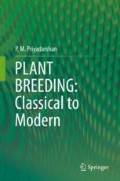Abstract
Genomics is the study on how the complex sets of genes are expressed in cells (the term genomics was coined by Tom Roderick, a geneticist at the Jackson Laboratory, Bar Harbor, USA, in 1986). It’s a discipline in genetics that applies recombinant DNA, DNA sequencing methods and bioinformatics to sequence, assemble and analyse the structure and function of genomes. Though the term genetic engineering is modification of plants and animals through recombinant DNA technology, human beings have been actually practising genetic engineering for thousands of years. The rate of crop improvement was increased because of an in-depth understanding of genetics during the beginning of the twentieth century. Introduction of hybrid corn was the most dramatic agricultural development. But highly inbred lines gave decreased yield because of homozygous deleterious recessive alleles. As per the observation of George Harrison Shull, crossing of two different inbred lines gave progeny with “hybrid vigour”, with fourfold yield. Hybrid rice of the International Rice Research Institute in the Philippines gave 20% extra yield. Currently, breeders are looking for genes to optimize nutritional quality like golden rice. Rice is staple food for almost half the world’s population, but it lacks vitamin A. Vitamin A deficiency causes reduced vision and immunity. Genetically engineered golden rice is with vitamin A. It has been named golden rice because of the gold-coloured beta-carotene, a precursor to vitamin A. The intensity of golden colour increases with the presence of pro-vitamin A. The commencement of the twenty-first century made new ways to understand genomes. The complexity of plant genomes is multi-fold compared to eukaryotic genomes with evolutionary flips and turns of DNA sequences. Chromosome numbers ploidy levels are also widely different. The size of plant genomes (both number of chromosomes and total nucleotide base pairs) shows the greatest variation in the biological world. As an example, wheat contains over 110 times more DNA compared to Arabidopsis thaliana. Plant DNA contains sequence repeats, sequence inversions or transposable element insertions that modify the genetic content further.
Access this chapter
Tax calculation will be finalised at checkout
Purchases are for personal use only
Abbreviations
- bp, kbp:
-
Base pairs, kilobase pairs
- ddNTPs:
-
Dideoxynucleotide triphosphates
- DH:
-
Doubled haploid
- DiGE:
-
Difference gel electrophoresis
- DNA:
-
Deoxyribonucleic acid
- DSB:
-
Double-strand break
- dsRNA:
-
Double-stranded RNAs
- ELISA:
-
Enzyme-linked immunosorbent assay
- FT-MS:
-
Fourier transform mass spectrometry
- GBSS:
-
Granule-bound starch synthase
- GC:
-
Gas chromatography
- GFP:
-
Green fluorescent protein
- GM:
-
Genetically modified
- GMM:
-
Genetically modified microorganism
- GMO:
-
Genetically modified organism
- GUS:
-
Beta-glucuronidase gene
- GVA:
-
Grapevine virus A
- HILIC:
-
Hydrophilic interaction chromatography
- HPLC:
-
High-performance liquid chromatography
- hpRNA:
-
Hairpin RNA
- HR:
-
Homologous recombination
- HRM:
-
High-resolution melting
- LC:
-
Liquid chromatography
- LFD:
-
Lateral flow devices
- LNA:
-
Locked nucleic acids
- LOD:
-
Limit of detection
- LOQ:
-
Limit of quantification
- MALDI:
-
Matrix-assisted laser-desorption ionization
- MAS:
-
Marker-assisted selection
- miRNA:
-
MicroRNA
- mRNA:
-
Messenger RNA
- MS:
-
Mass spectrometry
- MS-HRM:
-
Methylation-sensitive high-resolution melting
- ncRNA:
-
Non-coding RNA
- NHEJ:
-
Non-homologous end-joining
- NMR:
-
Nuclear magnetic resonance
- NOS:
-
Nopaline synthase
- NPTII:
-
Neomycin phosphotransferase gene
- nt:
-
Nucleotides
- NTTF:
-
New Techniques Task Force
- NTWG:
-
New Techniques Working Group
- ODM:
-
Oligonucleotide-directed mutagenesis
- OECD:
-
Organisation for Economic Co-operation and Development
- ORF:
-
Open reading frames
- PAGE:
-
Polyacrylamide gel electrophoresis
- PAT:
-
Phosphinothricin phosphotransferase
- PCR:
-
Polymerase chain reaction
- PCT:
-
Patent Cooperation Treaty
- PEG:
-
Polyethylene glycol
- PTA:
-
Plate-trapped antigen
- PTGS:
-
Post-transcriptional gene silencing
- RdDM:
-
RNA-dependent DNA methylation
- RNAi:
-
RNA interference
- RP:
-
Reversed-phase
- rRNA:
-
Ribosomal RNA
- RT qPCR:
-
Real-time quantitative PCR
- siRNA:
-
Small interfering RNA
- SNPs:
-
Single-nucleotide polymorphisms
- TALEN:
-
Transcription activator-like effector nucleases
- TAS:
-
Triple antibody sandwich
- T-DNA:
-
Transfer DNA
- TFO:
-
Triple helix-forming oligonucleotide
- TGS:
-
Transcriptional gene silencing
- TOF:
-
Time of flight
- tRNA:
-
Transfer RNA
- UHPLC:
-
Ultra-high-performance liquid chromatography
- UV:
-
Ultra-violet
- ZFN:
-
Zinc finger nuclease
Further Reading
Bolger ME et al (2014) Plant genome sequencing – applications for crop improvement. Curr Opin Biotechnol 26:31–37
Chakradhar T (2017) Genomic-based-breeding tools for tropical maize improvement. Genetica 145:525–539. https://doi.org/10.1007/s10709-017-9981-y
Kang YJ et al (2015) Translational genomics for plant breeding with the genome sequence explosion. Plant Biotechnol J:1–13. https://doi.org/10.1111/pbi.12449
Ronald PC (2014) Lab to farm: applying research on plant genetics and genomics to crop improvement. PLoS Biol 12:e1001878. https://doi.org/10.1371/journal.pbio.1001878
Songstad DD et al (2017) Genome editing of plants. Crit Rev Plant Sci 36:1–23. https://doi.org/10.1080/07352689.2017.1281663
Zhang X, Zhu Y, Wu H, Guo H (2016) Post-transcriptional gene silencing in plants: a double-edged sword. Sci China Life Sci 59:271–276. https://doi.org/10.1007/s11427-015-4972-7
Author information
Authors and Affiliations
Rights and permissions
Copyright information
© 2019 Springer Nature Singapore Pte Ltd.
About this chapter
Cite this chapter
Priyadarshan, P.M. (2019). Genomics. In: PLANT BREEDING: Classical to Modern. Springer, Singapore. https://doi.org/10.1007/978-981-13-7095-3_24
Download citation
DOI: https://doi.org/10.1007/978-981-13-7095-3_24
Published:
Publisher Name: Springer, Singapore
Print ISBN: 978-981-13-7094-6
Online ISBN: 978-981-13-7095-3
eBook Packages: Biomedical and Life SciencesBiomedical and Life Sciences (R0)

